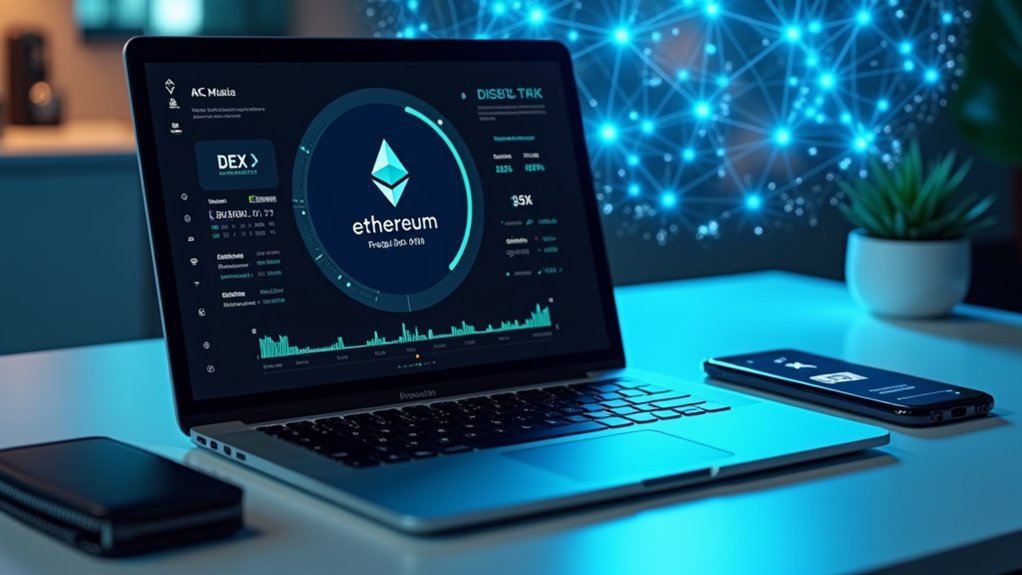Getting started with DeFi requires establishing a cryptocurrency wallet like MetaMask or Coinbase Wallet, securing the seed phrase offline, and funding it with Ethereum (ETH) acquired from centralized exchanges. Users can then access decentralized exchanges like Uniswap to trade tokens, or utilize lending protocols like Aave for borrowing and lending opportunities. Understanding blockchain fundamentals, practicing proper security measures, and researching platforms thoroughly minimizes risk exposure while traversing this revolutionary financial ecosystem.

Many investors and technology enthusiasts have found themselves intrigued by the expanding world of Decentralized Finance, commonly known as DeFi, which represents a fundamental shift in how financial services can be accessed and employed.
The entry point into this ecosystem invariably begins with setting up a compatible cryptocurrency wallet, with MetaMask and Coinbase Wallet emerging as the predominant options due to their robust browser and mobile unification capabilities.
The security of one's seed phrase, a sequence of words that grants access to digital assets, cannot be overstated; experts universally recommend offline storage of these credentials to mitigate the risk of unauthorized access or theft.
Funding these wallets requires Ethereum (ETH) as the foundational asset, which serves the dual purpose of investment vehicle and payment for transaction fees, commonly referred to as "gas." Users can acquire ETH through established centralized exchanges like Binance or Coinbase, then transfer these assets to their self-custodial wallets using the wallet's unique alphanumeric public address.
For those seeking to utilize assets across multiple blockchains, Ethereum bridges facilitate the movement of digital assets between networks such as Ethereum and Polygon, expanding investment opportunities beyond a single ecosystem.
Once funded, users gain access to decentralized exchanges (DEXs) like Uniswap and Sushiswap, which operate through automated market makers rather than traditional order books, enabling permissionless trading of thousands of tokens.
These platforms additionally offer liquidity mining opportunities, wherein users provide asset pairs to trading pools in exchange for proportional trading fees and governance tokens.
Advanced DeFi participants often utilize lending protocols such as Aave and Compound, which enable the borrowing and lending of assets at algorithmically determined interest rates based on supply and demand interactions. These protocols operate without intermediaries, allowing for direct peer-to-peer financial transactions on the blockchain. Smart contracts automatically manage loan terms, enabling users to earn higher yield rates than traditional banking institutions while maintaining complete control of their assets.
For those operating within the Binance Smart Chain ecosystem, PancakeSwap offers similar functionality with generally lower transaction costs, though with potentially different risk profiles and yield opportunities compared to Ethereum-based alternatives. Newcomers should be aware that the DeFi landscape contains numerous risks and scams that require diligent research before committing any significant assets.
Frequently Asked Questions
What Are the Tax Implications of Defi Investments?
DeFi investments carry significant tax consequences since the IRS treats cryptocurrency as property.
Capital gains tax applies to trading activities and swaps, while ordinary income tax applies to staking rewards, lending interest, and airdrops.
Investors must track cost basis meticulously, report dispositions on Form 8949, document income on Schedule 1, and distinguish between short and long-term holdings.
Regulatory gaps persist, however, as specific DeFi protocol guidance remains limited, forcing reliance on legacy cryptocurrency regulations.
How Can I Recover Funds Sent to the Wrong Address?
Recovering funds sent to incorrect addresses depends on several technical factors, including blockchain type, address validity, and recipient cooperation.
Users should first verify transaction details through blockchain explorers and determine if the error involves compatible networks.
For tokens with unique identifiers like XLM or XRP, recovery may be possible through formal exchange protocols, while other situations may require professional forensic services that typically retain 10% of recovered amounts, subject to minimum value thresholds.
Are Hardware Wallets Necessary for Defi Security?
Hardware wallets, while not absolutely necessary, provide significant security advantages for DeFi participation compared to software alternatives.
They create an air-gapped environment for private keys, mitigating risks from malware, phishing, and remote exploits that frequently target DeFi users.
For substantial investments or long-term holdings, hardware wallets represent a prudent security measure that substantially reduces attack vectors through physical transaction verification and offline key storage protocols.
Which Blockchains Offer the Lowest Gas Fees for Defi?
Blockchains offering the lowest gas fees for DeFi transactions include Solana and Polygon, which maintain costs at fractions to a few cents per transaction.
Solana utilizes high throughput architecture and efficient consensus mechanisms to sustain low-cost operations, while Polygon, functioning as Ethereum's layer 2 solution, employs Proof-of-Stake consensus to reduce fees considerably.
Both networks facilitate rapid settlement times and low latency, making them particularly suitable for frequent DeFi activities requiring cost-effective execution.
How Do Flash Loans Work in Defi?
Flash loans in DeFi operate like uncollateralized lending instruments that execute borrowing and repayment within a single transaction block.
These sophisticated financial tools enable traders to access significant capital without upfront collateral, provided all borrowed funds return to the lender by transaction completion.
The atomic execution mechanism, ensuring transactions revert entirely if repayment fails, protects lenders while assisting complex arbitrage strategies, liquidations, and collateral swaps for borrowers seeking to capitalize on short-term market inefficiencies.









